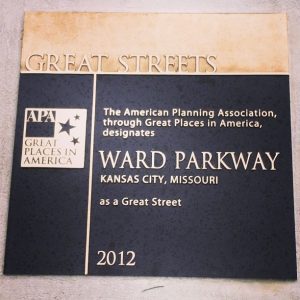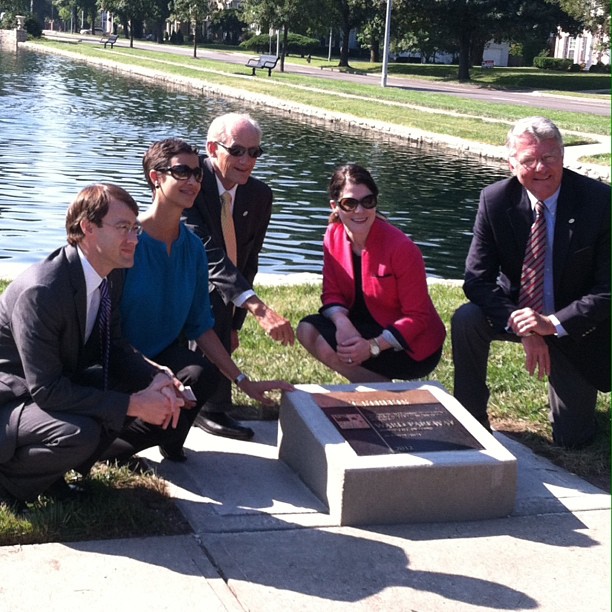 Last October, the American Planning Association (APA) announced the designation of Ward Parkway as one of 10 Great Streets for 2012 under the organization’s Great Places in America program. APA Great Places exemplify exceptional character and highlight the role planning and planners play in adding value to communities, including fostering economic growth and jobs. Today, a ceremony was held to unveil a plaque officially designating Ward Parkway as a 2012 Great Street. The plaque is located on the north side of Mirror Pool Fountain, Ward Parkway and W. 61st St.
Last October, the American Planning Association (APA) announced the designation of Ward Parkway as one of 10 Great Streets for 2012 under the organization’s Great Places in America program. APA Great Places exemplify exceptional character and highlight the role planning and planners play in adding value to communities, including fostering economic growth and jobs. Today, a ceremony was held to unveil a plaque officially designating Ward Parkway as a 2012 Great Street. The plaque is located on the north side of Mirror Pool Fountain, Ward Parkway and W. 61st St.
APA singled out Ward Parkway, one of Kansas City’s most prestigious street addresses, for its picturesque scenery, striking ornamentation, magnificent houses, and variety of uses. The boulevard, designed by renowned landscape architect George Kessler, ambles along a gently undulating landscape, at times paralleling Bush Creek and the Missouri-Kansas border.
“Ward Parkway is one of the crown jewels of Kansas City’s 135-mile boulevard and parkway system”, says KC Parks Director Mark McHenry. “Parkways and Boulevards are defining features of Kansas City that tie our communities together with ribbons of green and balance the need to move traffic with a desire to maintain a ‘City within a Park’ feel.”
Through Great Places in America, APA recognizes streets, neighborhoods, and public spaces featuring unique and authentic characteristics that have evolved from years of thoughtful and deliberate planning by residents, community leaders and planners. The 2012 Great Places illustrate how the foresight of planning fosters tomorrow’s communities and they have many of the features Americans say are important to their “ideal community” including locally owned businesses, transit, neighborhood parks, and sidewalks.
Since APA began Great Places in America in 2007, 60 neighborhoods, 60 streets and 50 public spaces have been designated in 50 states and the District of Columbia.
“Planned as Kansas City’s premiere residential boulevard, Ward Parkway is a monument to the City Beautiful movement,” said APA Chief Executive Officer Paul Farmer, FAICP. “This Great Street embraces the natural terrain of the area, complementing the historic apartment buildings, shopping plazas, businesses, mansions and parks found along this right-of-way,” he added.
Ward Parkway begins its 12-mile, southerly run at Country Club Plaza, the nation’s first auto-oriented regional shopping center. Cars, however, take a back seat to the pedestrian experience and are concealed in multilevel garages beneath and behind shops or on building rooftops. Opened in 1922, the plaza reflects classic European influences and features over $1 million in public art. Its iconic J.C. Nichols Memorial Fountain, along with several others, contributes to Kansas City’s reputation as The City of Fountains.
Fountains punctuate Ward Parkway. The Mirror Pool Fountain, built in 1924 and renovated in 1965, fills an entire city block while the Seahorse Fountain, with its spectacular 17th-century Venetian sculpture, adorns the parkway’s Meyer Circle. Monuments are scattered throughout the boulevard as well.
Parkway maintenance and enhancements have been funded, in part, by earmarked revenues, including a one-cent capital improvement sales tax, renewed in 2007 for 10 years, and an arterial impact fee, assessed on any new developments along the parkway. Last year saw the establishment of the Ward Parkway Center Community Improvement District to raise funds for redevelopment of this 1959 retail outlet.
Improvements and enhancements are not exclusive to the public sector. Last year, the engineering firm of Burns & McDonnell announced it would spend $20 million to renovate its headquarters at the southern end of Ward Parkway and build a 450-seat auditorium, conference center, and wellness clinic.
Ward Parkway contains numerous historic properties and a single historic district. Comprising that district are three reinforced concrete apartment buildings with a Spanish Revival motif. These mid-1920s structures were erected when it became evident to developer J.C. Nichols that the density of his exclusive Country Club District would not support Country Club Plaza.
Historic mansions and houses of architectural significance grace Ward Parkway, the earliest being the 30,000 square-foot mansion of a lumber tycoon. Among the houses added to the National Register are those in the Antebellum, Prairie, and Neo-Classical Revival styles.
The nine other APA 2012 Great Streets are: Duval Street, Key West, FL; Main Street, Bozeman, MT; Broadway, Saratoga Springs, NY; Fifth Avenue, New York City, NY; Wall Street, Kingston, NY; Shaker Boulevard, Cleveland, Shaker Heights and Beachwood, OH; Grant Street, Pittsburgh, PA; Broad Street, Charleston, SC; and Gay Street, Knoxville, TN.
For more information about these public spaces, as well as APA’s top 10 Great Neighborhoods and top 10 Great Public Spaces, visit www.planning.org/greatplaces. This year’s Great Places in America are being celebrated as part of APA’s National Community Planning Month during October; for more about the special month, visit www.planning.org/ncpm.
